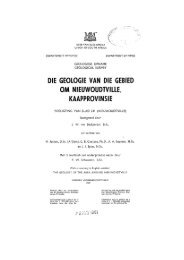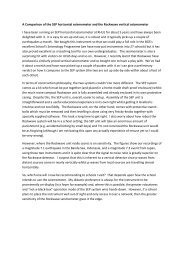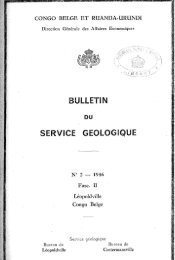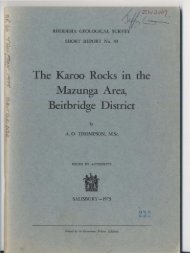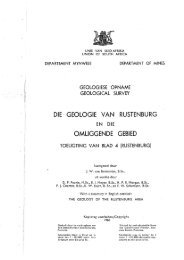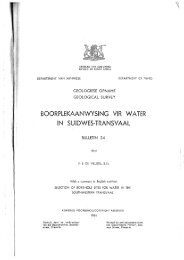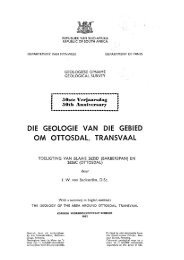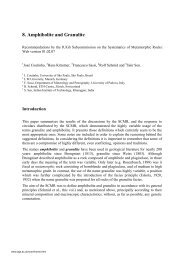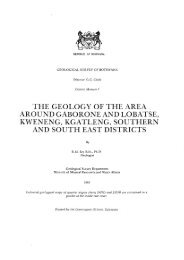Bibliography - British Geological Survey
Bibliography - British Geological Survey
Bibliography - British Geological Survey
You also want an ePaper? Increase the reach of your titles
YUMPU automatically turns print PDFs into web optimized ePapers that Google loves.
Pycraft, W. P. 1913. Ape-man or modern man? The two Piltdown skull reconstructions. Illustrated London<br />
News, 143 (Sept), 282. (Stoutly defends Smith Woodward’s reconstruction of the Piltdown skull against the<br />
alternative restoration put forward by Arthur Keith. ‘According to Professor Arthur Keith, of the Royal<br />
College of Surgeons, Eoanthropus might have edited a newspaper. According to Dr. Smith Woodward, of<br />
the <strong>British</strong> Museum, he would have made a very poor “printer’s devil.” Who shall decide between them?’)<br />
Pycraft, W. P. 1916. [Discussion of the findings of W. C. Lyne 1916.] Proceedings of the Royal Society of<br />
Medicine, 9, 58.<br />
Pycraft, W. P. 1917a. The jaw of the Piltdown Man: a reply to Mr. Gerrit S. Miller. Science Progress, 11,<br />
no. 43, 389–409. (A stern and detailed response to Millers assertion (1915) that the Piltdown jaw and<br />
cranium do not belong together. He considers that Miller’s ‘unfortunate lack of the right perspective has<br />
caused him to overlook some of the most significant features of these remains, and has absolutely warped his<br />
judgement in regard to the relative values of the likenesses between these fragments and the skulls of the<br />
chimpanzee which he has so woefully misread.’ W. K. Gregory (correspondence in Spencer 1990b, 145‒6)<br />
described Pycraft’s response as ‘impudent and bombastic’.)<br />
Pycraft, W. P. 1917b (contribution to discussion in Woodward 1917b, in which he dismisses Miller’s<br />
attempt to compare the Piltdown jaw with that of an abnormal chimpanzee; see also Woodward 1918)<br />
Quenstedt, W. & A. 1936. Fossilium catalogus. I: Animalia. Pars 74: Hominidae fossiles. Hague: W. Junk<br />
(?Eoanthropus dawsoni Woodward 1913: including list of synonyms; 317 author citations are indexed<br />
chronologically from 1912 to 1935, pp. 191–197; references in main bibliography, pp. 8–174.)<br />
Ramström, M. 1916. Om underkäken i Piltdown-fyndet (“Eoanthropus”). Svenska Läkaresällskapets<br />
Handlinger, 42 (3), 1223–1256 (Swedish with German summary).<br />
Ramström, M. 1919. Der Piltdown-Fund. Bulletin of the <strong>Geological</strong> Institution of the University of Upsala,<br />
16, 261–304. (Argues, in agreement with G. S. Miller and D. Waterston, that the Piltdown jaw is more like<br />
that of a chimpanzee)<br />
Ramström, M. 1921. Der Java-Trinil-Fund “Pithecanthropus” oder: Können die “Eoanthropus”- und<br />
“Pithecanthropus”- Funde uns zuverlässige Aufschlüsse über die Anthropogenesis geben? Uppsala<br />
Läkareförenings Förhandlinger, N.F., 26, 1–37. (Eoanthropus, pp. 3–6)<br />
Read, C. H. 1893. [Observations on an iron statuette believed to have been found in Sussex, exhibited before<br />
the Society by Charles Dawson.] Proceedings of the Society of Antiquaries of London, ser. 2, 14 (18 May),<br />
359–361 (with discuss). (C. H. Read, Secretary of the Society, stated that the statuette had been ‘found in<br />
1877 in Beauport Park, Sussex, in digging in a slag mound (locally called a cinder heap) at a depth of 27 feet,<br />
and that human bones were found near the bottom of the heap.’ The statuette was clearly Roman in style, and<br />
though greatly decayed it appeared to represent a miniature copy of a horseman from the Quirinal at Rome. An<br />
attempt had been made to ascertain whether the figure was of wrought or cast iron (Dawson himself thought<br />
it to be the latter). An analysis by W. C. Roberts-Austen (Professor of Metallurgy at the Royal School of Mines)<br />
concluded that it was not of cast iron. In the discussion that followed, A. H. Smith exhibited another statuette<br />
of the same design in bronze which had been obtained in southern France and was stated to be Roman, though<br />
he considered it to be modern. The general view of the meeting was that the statuette was a modern replica.<br />
This was not the outcome that Dawson had wanted and he continued to gather evidence to support a view<br />
that would eventually emerge in his 1903 paper on Sussex iron work. See Russell 2003, 61–70, for a full<br />
discussion of this artefact, and Dawson 1903 for links to other published references.)<br />
Reader, J. 1981. Missing links: the hunt for the earliest man. London: Collins, 272 pp. (Piltdown Man,<br />
pp. 55‒81, & bibliography, pp. 252‒253)<br />
Reid, C. (contribution to discussion in Dawson & Woodward 1912)<br />
Reynolds, V. 1982. Obituary: Joseph S. Weiner. Royal Anthropological Institute Newsletter, no. 52 (Oct),<br />
15–16.<br />
Reynolds, V. (see also Miles, H. 2003)<br />
Roberts, N. K. 2000. From Piltdown Man to point omega: the evolutionary theory of Teilhard de Chardin.<br />
New York: Peter Lang Publishing Inc, 251 pp. (Studies in European Thought, vol. 18). (Touches on the<br />
question of why there are so few references to Piltdown in Teilhard’s later works)



